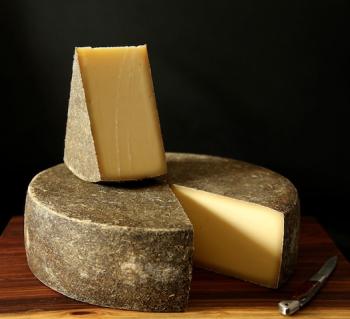Heublumen
- Producer
- Käserei Stofel
- Country
- Switzerland
- Region
- St Gallen
- Size
- 12 ins diameter, 3 ins high
- Weight
- 14 lbs
- Website
- www.bergmilch.ch
- Milk
- Cow
- Classification
- Firm
- Rennet
- Animal
- Rind
- Herbed

Founded in 1983, Käserei Stofel is located in the town of Unterwasser in the north-eastern part of the canton (region) of St Gallen in Switzerland. There, second generation cheesemaker, Thomas Stadelmann makes a variety of cheeses and dairy products such as yogurts from organic milk at his small, family owned dairy.
Stadelmann trained as a cheesemaker in the western area of Switzerland by making Gruyere. Then in 2000, he took over the running and operation of the family dairy from his father. By nature, Thomas has a passion for creating new and original cheeses, many of which have won multiple awards.
Named Heublumen after the German word for “hayflower” in which the cheese is coated, this cheese is a riff on some of the more traditional Swiss Alpine style cheeses found in the region.
For production of Heublumen, organic milk is heated in a copper vat and starter cultures and rennet are added. After the curd is cut and the excess whey drained off, large blocks of curd are placed into cheese forms and pressed. After pressing, the newly formed wheels are soaked in a brine solution for twenty four hours in order to expel more whey and to help with the formation of a rind.
The wheels are then transferred to a maturing room where they are matured for two months before a dense coat of bits of hay is applied to the outside. Stadelmann has a proprietory method for ensuring the hay remains stuck to the outsode of the cheese and doesn’t fall off.
The cheeses are then aged for a further two months before release. During this time, they are regularly brushed to keep any mold from developing.
Tasting Notes
By the time Heublumen is released for sale, the interior of the cheese is pale straw colored with a firm texture dotted with occasional small holes or “eyes”. The exterior rind is a dark green/brown in color and flecked with small pieces of hay.
Flavors are milky and delicate with notes of sweet, raw almonds becoming more woodsy and barnyard-like near the rind.



